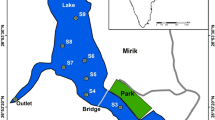Abstract
Concentrations of lead (Pb), copper (Cu), zinc (Zn), and cadmium (Cd) were evaluated in the sediments, roots and leaves of a mangrove species (Avicennia marina) in Las Piñas—Parañaque Critical Habitat and Ecotourism Area (LPPCHEA), Manila Bay. The concentrations showed a general pattern of Zn > Pb > Cu > Cd in sediments, Cu > Pb > Zn > Cd in roots and Cu > Zn > Pb > Cd in leaves. The trace metal concentrations in both sediments and plant tissues were below contamination threshold levels. Based on computed bioaccumulation indices, A. marina could be used for the phytostabilization and phytoextraction of Cu and Cd. The LPPCHEA mangrove ecosystem is an ecologically important ecosystem that will limit the spread of trace metals to the surrounding environment.

Similar content being viewed by others
References
Almahasheer HB, Al-Taisan WA, Mohamed MK (2013) Metals accumulation in grey mangrove (Avicennia marina (Forsk.) Vierh.) inhabiting Tarut Bay, Eastern Saudi Arabia. J Agric Sci 6:137–149. doi:10.5539/jas.v6n1p137
Baker AJ, Walker PI (1990) Ecophysiology of metal uptake by tolerant plants. In: Shaw AJ (ed) Heavy metal tolerance in plants: evolutionary aspects. CRC Press, Florida, pp 155–178
Cheraghi M, Lorestani B, Khorasani N, Yousefi N, Karami M (2011) Findings on the phytoextraction and phytostabilization of soils contaminated with heavy metals. Biol Trace Elem Res 144(1–3):1133–1141
Cui S, Zhou Q, Chao L (2007) Potential hyper-accumulation of Pb, Zn, Cu and Cd in endurant plants distributed in an old smeltery, northeast China. Environ Geol 51:1043–1048
Driscoll CT, Otton JK, Iverfeldt A (1994) Trace metals speciation and cycling. In: Moldan B, Cerny J (eds) Biogeochemistry of small catchments: a tool for environmental research. John Wiley and Sons, New York. pp 299–322
Du Laing G, Rinklebe J, Vandecasteele B, Meers E, Tack FMG (2009) Trace metal behavior in estuarine and riverine floodplain soils and sediments: a review. Sci Total Environ 407:3972–3985
Helrich K (1990) Official methods of analysis of AOAC. Volume 2 (15th edn), Association of Official Analytical Chemists, Inc., Virginia, USA
Hosono T, Su C, Siringan F, Amano A, Onodera S (2010) Effects of environmental regulations on heavy metal pollution decline in core sediments from Manila Bay. Mar Pollut Bull 60:780–785
Kabata-Pandias A, Mukherjee AB (2007) Trace elements from soil to human. Springer, Berlin
Kularatne R (2014) Phytoremediation of Pb by Avicennia marina (Forsk.) Vierh and spatial variation of Pb in the Batticaloa Lagoon, Sri Lanka during driest periods: a field study. Int J Phytorem 16:509–523
Lacerda LD (1997) Trace metals in mangrove plants: why such low concentrations? In: De Lacerda LD, Diops HS (eds.), Mangrove ecosystem studies in Latin America and Africa. UNESCO, pp. 171–178
Li MS, Luo YP, Su ZY (2007) Heavy metal concentrations in soils and plant accumulation in a restored manganese mineland in Guangxi, South China. Environ Pollut 147:168–175
Lotfinasabasl S, Gunale VR (2012) Studies on heavy metals bioaccumulation potential of mangrove species, Avicennia marina. IJEST 4:4411–4421
MacFarlane GR, Burchett MD (2000) Cellular distribution of copper, lead and zinc in the grey mangrove, Avicennia marina (Forsk.) Vierh. Aquat Bot 68:45–59
MacFarlane GR, Pulkownik A, Burchett MD (2003) Accumulation and distribution of heavy metals in the grey mangrove, Avicennia marina (Forsk.)Vierh.: biological indication potential. Environ Pollut 123:139–151
MacFarlane GR, Koller CE, Blomberg SP (2007) Accumulation and partitioning of heavy metals in mangroves: a synthesis of field-based studies. Chemosphere 69:1454–1464
Malik RN, Husain SZ, Nazir I (2010) Heavy metal contamination and accumulation in soil and wild plant species from industrial area of Islamabad, Pakistan. Pak J Bot 42:291–301
Matagi SV, Swai D, Mugabe R (1998) A review of heavy metal removal mechanisms in wetlands. Afr J Trop Hydrobiol Fish 8:23–35
Mayor-Gordove D, Aguinaldo R (2013) Information Sheet on Ramsar Wetlands—Ramsar Site no. 2124. Department of Environment and Natural Resources. http://sites.wetlands.org/reports/ris/2PH006_RIS_2013.pdf. Accessed 16 Jan 2014
Parvaresh H, Abedi Z, Farshchi P, Karami M, Khorasani N, Karbassi A (2011) Bioavailability and concentration of heavy metals in the sediments and leaves of grey mangrove, Avicennia marina (Forsk.) Vierh, in Sirik Azini Creek, Iran. Biol Trace Elem Res 143:1121–1130
Peng JF, Song YH, Yuan P, Cui XY, Qiu GL (2009) The remediation of heavy metals contaminated sediment. J Hazard Mater 161:633–640
Philippine Statistics Authority (2010) Population. http://www.nscb.gov.ph/. Accessed 18 March 2014
Pilon-Smits E (2005) Phytoremediation. Annu Rev Plant Biol 56:15–39
Prudente MS, Ichihashi H, Tatsukawa R (1994) Heavy metal concentrations in sediments from Manila Bay, Philippines and inflowing rivers. Environ Pollut 86:83–88
Prudente MS, Kim EY, Tanabe S, Tatsukawa R (1997) Metal levels in some commercial fish species from Manila Bay, the Philippines. Mar Poll Bull 34(8):671–674
R Core Team (2013) R: a language and environment for statistical computing (Version 3.0.2). R Foundation for Statistical Computing, Vienna, Austria. http://www.R-project.org/
Uppangala N (2010) Phytoremediation for heavy metals. http://www.biotecharticles.com/ Environmental-Biotechnology-Article/Phytoremediation-For-Heavy-Metals-178.html. Accessed 16 Jan 2014
Usman ARA, Alkredaa RS, Al-Wabel MI (2013) Heavy metal contamination in sediments and mangroves from the coast of Red Sea: Avicennia marina as potential metal bioaccumulator. Ecotoxicol Environ Saf 97(2013):263–270
Velasquez IB, Jacinto GS, Valera FS (2002) The speciation of dissolved copper, cadmium, and zinc in Manila Bay, Philippines. Mar Pollut Bull 45:210–217
Yoon J, Cao X, Zhou Q, Ma LQ (2006) Accumulation of Pb, Cu, and Zn in native plants growing on a contaminated Florida site. Sci Total Environ 368:456–464
Acknowledgments
We thank Sanggunian ng mga Paaralang Loyola ng Ateneo de Manila for the financial support and the Department of Environment and Natural Resources—National Capital Region for their assistance in this study. Dr. Ian Navarrete of the Environmental Science Department of the Ateneo de Manila University helped us improve the manuscript.
Author information
Authors and Affiliations
Corresponding author
Rights and permissions
About this article
Cite this article
Gabriel, A.V.S., Salmo, S.G. Assessment of Trace Metal Bioaccumulation by Avicennia marina (Forsk.) in the Last Remaining Mangrove Stands in Manila Bay, the Philippines. Bull Environ Contam Toxicol 93, 722–727 (2014). https://doi.org/10.1007/s00128-014-1415-2
Received:
Accepted:
Published:
Issue Date:
DOI: https://doi.org/10.1007/s00128-014-1415-2




